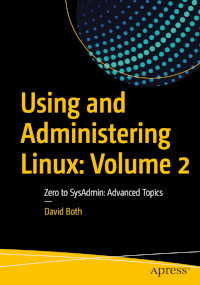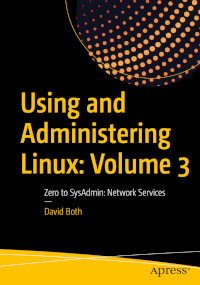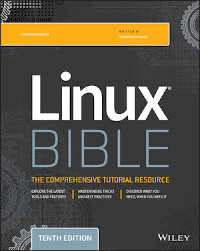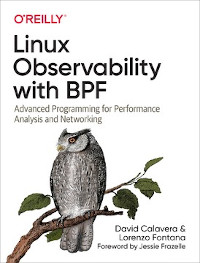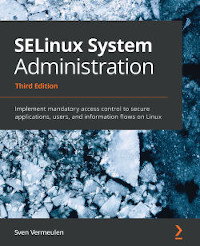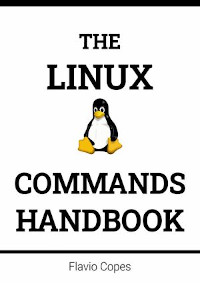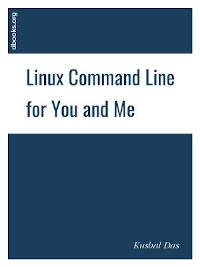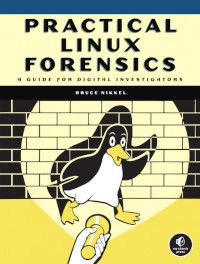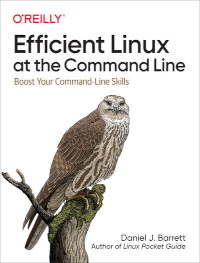Using and Administering Linux: Volume 2
Experience an in-depth exploration of logical volume management and the use of file managers to manipulate files and directories and the critical concept that, in Linux, everything is a file and some fun and interesting uses of the fact that everything is a file. This book builds upon the skills you learned in Volume 1 of this course and it depends upon the virtual network and virtual machine created there. More experienced Linux users can begin with this volume and download the assigned script that will set up the VM for the start of Volume 2. Instructions with the script will provide specifications for configuration of the virtual network and the virtual machine. Refer to the volume overviews in the book's introduction to select the volume of this course most appropriate for your current skill level. You'll see how to manage and monitor running processes, discover the power of the special filesystems, monitor and tune the kernel while it is running - without a reboot. You'll th ...
Experience an in-depth exploration of logical volume management and the use of file managers to manipulate files and directories and the critical concept that, in Linux, everything is a file and some fun and interesting uses of the fact that everything is a file. This book builds upon the skills you learned in Volume 1 of this course and it depends upon the virtual network and virtual machine created there. More experienced Linux users can begin with this volume and download the assigned script that will set up the VM for the start of Volume 2. Instructions with the script will provide specifications for configuration of the virtual network and the virtual machine. Refer to the volume overviews in the book's introduction to select the volume of this course most appropriate for your current skill level. You'll see how to manage and monitor running processes, discover the power of the special filesystems, monitor and tune the kernel while it is running - without a reboot. You'll th ...
Using and Administering Linux: Volume 3
Manage complex systems with ease and equip yourself for a new career. This book builds upon the skills you learned in Volumes 1 and 2 of this course and it depends upon the virtual network and virtual machine you created there. However, more experienced Linux users can begin with this volume and download an assigned script that will set up the VM for the start of Volume 3. Instructions with the script will provide specifications for configuration of the virtual network and the virtual machine. Refer to the volume overviews in the book's introduction to select the volume of this course most appropriate for your current skill level. Start by reviewing the administration of Linux servers and install and configure various Linux server services such as DHCP, DNS, NTP, and SSH server that will be used to provide advanced network services. You'll then learn to install and configure servers such as BIND for name services, DHCP for network host configuration, and SSH for secure logins to ...
Manage complex systems with ease and equip yourself for a new career. This book builds upon the skills you learned in Volumes 1 and 2 of this course and it depends upon the virtual network and virtual machine you created there. However, more experienced Linux users can begin with this volume and download an assigned script that will set up the VM for the start of Volume 3. Instructions with the script will provide specifications for configuration of the virtual network and the virtual machine. Refer to the volume overviews in the book's introduction to select the volume of this course most appropriate for your current skill level. Start by reviewing the administration of Linux servers and install and configure various Linux server services such as DHCP, DNS, NTP, and SSH server that will be used to provide advanced network services. You'll then learn to install and configure servers such as BIND for name services, DHCP for network host configuration, and SSH for secure logins to ...
Linux Bible, 10th Edition
Linux Bible, 10th Edition is the ultimate hands-on Linux user guide, whether you're a true beginner or a more advanced user navigating recent changes. this updated tenth edition covers the latest versions of Red Hat Enterprise Linux (RHEL 8), Fedora 30, and Ubuntu 18.04 LTS. It includes information on cloud computing, with new guidance on containerization, Ansible automation, and Kubernetes and OpenShift. With a focus on RHEL 8, this new edition teaches techniques for managing storage, users, and security, while emphasizing simplified administrative techniques with Cockpit. Written by a Red Hat expert, this book provides the clear explanations and step-by-step instructions that demystify Linux and bring the new features seamlessly into your workflow. This useful guide assumes a base of little or no Linux knowledge, and takes you step by step through what you need to know to get the job done. Get Linux up and running quickly; Master basic operations and tackle more advanced tasks; ...
Linux Bible, 10th Edition is the ultimate hands-on Linux user guide, whether you're a true beginner or a more advanced user navigating recent changes. this updated tenth edition covers the latest versions of Red Hat Enterprise Linux (RHEL 8), Fedora 30, and Ubuntu 18.04 LTS. It includes information on cloud computing, with new guidance on containerization, Ansible automation, and Kubernetes and OpenShift. With a focus on RHEL 8, this new edition teaches techniques for managing storage, users, and security, while emphasizing simplified administrative techniques with Cockpit. Written by a Red Hat expert, this book provides the clear explanations and step-by-step instructions that demystify Linux and bring the new features seamlessly into your workflow. This useful guide assumes a base of little or no Linux knowledge, and takes you step by step through what you need to know to get the job done. Get Linux up and running quickly; Master basic operations and tackle more advanced tasks; ...
Linux Observability with BPF
Build your expertise in the BPF virtual machine in the Linux kernel with this practical guide for systems engineers. You'll not only dive into the BPF program lifecycle but also learn to write applications that observe and modify the kernel's behavior; inject code to monitor, trace, and securely observe events in the kernel; and more. Authors David Calavera and Lorenzo Fontana help you harness the power of BPF to make any computing system more observable. Familiarize yourself with the essential concepts you'll use on a day-to-day basis and augment your knowledge about performance optimization, networking, and security. Then see how it all comes together with code examples in C, Go, and Python. Write applications that use BPF to observe and modify the Linux kernel's behavior on demand; Inject code to monitor, trace, and observe events in the kernel in a secure way - no need to recompile the kernel or reboot the system; Explore code examples in C, Go, and Python; Gain a more thorou ...
Build your expertise in the BPF virtual machine in the Linux kernel with this practical guide for systems engineers. You'll not only dive into the BPF program lifecycle but also learn to write applications that observe and modify the kernel's behavior; inject code to monitor, trace, and securely observe events in the kernel; and more. Authors David Calavera and Lorenzo Fontana help you harness the power of BPF to make any computing system more observable. Familiarize yourself with the essential concepts you'll use on a day-to-day basis and augment your knowledge about performance optimization, networking, and security. Then see how it all comes together with code examples in C, Go, and Python. Write applications that use BPF to observe and modify the Linux kernel's behavior on demand; Inject code to monitor, trace, and observe events in the kernel in a secure way - no need to recompile the kernel or reboot the system; Explore code examples in C, Go, and Python; Gain a more thorou ...
Linux Containers and Virtualization
Get a novel perspective on Linux containers and understand the world of virtualization. This book takes you down the rabbit hole to discover what lies below the API. You'll go on a journey of virtualization and see how containers are realized in the Linux world. Linux Containers and Virtualization details the data structures within the Linux kernel which make up Linux containers. You will start with the fundamentals of virtualization including how different resources such as memory, CPU, network, and storage are virtualized. Then you will move on to hypervisors and virtualization using the Kernel virtual Machine (KVM) and Quick Emulator (QEMU). Next, you will learn about Linux namespace, cgroups, and layered file systems, which are the essential building blocks of Linux containers. The explanation traverses the Linux kernel codebase to show how these are realized in the Linux kernel. In the final chapter, you will code your own container by applying the concepts learnt in the previ ...
Get a novel perspective on Linux containers and understand the world of virtualization. This book takes you down the rabbit hole to discover what lies below the API. You'll go on a journey of virtualization and see how containers are realized in the Linux world. Linux Containers and Virtualization details the data structures within the Linux kernel which make up Linux containers. You will start with the fundamentals of virtualization including how different resources such as memory, CPU, network, and storage are virtualized. Then you will move on to hypervisors and virtualization using the Kernel virtual Machine (KVM) and Quick Emulator (QEMU). Next, you will learn about Linux namespace, cgroups, and layered file systems, which are the essential building blocks of Linux containers. The explanation traverses the Linux kernel codebase to show how these are realized in the Linux kernel. In the final chapter, you will code your own container by applying the concepts learnt in the previ ...
SELinux System Administration, 3rd Edition
Linux is a dominant player in many organizations and in the cloud. Securing the Linux environment is extremely important for any organization, and Security-Enhanced Linux (SELinux) acts as an additional layer to Linux system security. SELinux System Administration covers basic SELinux concepts and shows you how to enhance Linux system protection measures. You will get to grips with SELinux and understand how it is integrated. As you progress, you'll get hands-on experience of tuning and configuring SELinux and integrating it into day-to-day administration tasks such as user management, network management, and application maintenance. Platforms such as Kubernetes, system services like systemd, and virtualization solutions like libvirt and Xen, all of which offer SELinux-specific controls, will be explained effectively so that you understand how to apply and configure SELinux within these applications. If applications do not exert the expected behavior, you'll learn how to fine-tune p ...
Linux is a dominant player in many organizations and in the cloud. Securing the Linux environment is extremely important for any organization, and Security-Enhanced Linux (SELinux) acts as an additional layer to Linux system security. SELinux System Administration covers basic SELinux concepts and shows you how to enhance Linux system protection measures. You will get to grips with SELinux and understand how it is integrated. As you progress, you'll get hands-on experience of tuning and configuring SELinux and integrating it into day-to-day administration tasks such as user management, network management, and application maintenance. Platforms such as Kubernetes, system services like systemd, and virtualization solutions like libvirt and Xen, all of which offer SELinux-specific controls, will be explained effectively so that you understand how to apply and configure SELinux within these applications. If applications do not exert the expected behavior, you'll learn how to fine-tune p ...
The Linux Commands Handbook
The Linux Commands Handbook follows the 80/20 rule: learn in 20% of the time the 80% of a topic. The author find this approach gives a well-rounded overview. This book does not try to cover everything under the sun related to Linux and its commands. It focuses on the small core commands that you will use the 80% or 90% of the time, trying to simplify the usage of the more complex ones. All those commands work on Linux, macOS, WSL, and anywhere you have a UNIX environment. The author hopes the contents of this book will help you achieve what you want: get comfortable with Linux. ...
The Linux Commands Handbook follows the 80/20 rule: learn in 20% of the time the 80% of a topic. The author find this approach gives a well-rounded overview. This book does not try to cover everything under the sun related to Linux and its commands. It focuses on the small core commands that you will use the 80% or 90% of the time, trying to simplify the usage of the more complex ones. All those commands work on Linux, macOS, WSL, and anywhere you have a UNIX environment. The author hopes the contents of this book will help you achieve what you want: get comfortable with Linux. ...
Linux Command Line for You and Me
The command line is a text interface for your computer. It's a program that takes in commands, which it passes on to the computer's operating system to run. Linux command line for you and me is a open book for newcomers to command line environment. ...
The command line is a text interface for your computer. It's a program that takes in commands, which it passes on to the computer's operating system to run. Linux command line for you and me is a open book for newcomers to command line environment. ...
Practical Linux Forensics
Practical Linux Forensics dives into the technical details of analyzing postmortem forensic images of Linux systems that have been misused, abused, or the target of malicious attacks. This essential practitioner's guide will show you how to locate and interpret digital evidence found on Linux desktops, servers, and IoT devices, draw logical conclusions, and reconstruct timelines of past activity after a crime or security incident. It's a book written for investigators with varying levels of Linux experience, and the techniques shown are independent of the forensic analysis platform and tools used. Early chapters provide an overview of digital forensics as well as an introduction to the Linux operating system and popular distributions. From there, the book describes the analysis of storage, filesystems, files and directories, installed software packages, and logs. Special focus is given to examining human user activity such as logins, desktop environments and artifacts, home director ...
Practical Linux Forensics dives into the technical details of analyzing postmortem forensic images of Linux systems that have been misused, abused, or the target of malicious attacks. This essential practitioner's guide will show you how to locate and interpret digital evidence found on Linux desktops, servers, and IoT devices, draw logical conclusions, and reconstruct timelines of past activity after a crime or security incident. It's a book written for investigators with varying levels of Linux experience, and the techniques shown are independent of the forensic analysis platform and tools used. Early chapters provide an overview of digital forensics as well as an introduction to the Linux operating system and popular distributions. From there, the book describes the analysis of storage, filesystems, files and directories, installed software packages, and logs. Special focus is given to examining human user activity such as logins, desktop environments and artifacts, home director ...
Efficient Linux at the Command Line
Take your Linux skills to the next level! Whether you're a system administrator, software developer, site reliability engineer, or enthusiastic hobbyist, this practical, hands-on book will help you work faster, smarter, and more efficiently. You'll learn how to create and run complex commands that solve real business problems, process and retrieve information, and automate manual tasks. You'll also truly understand what happens behind the shell prompt, so no matter which commands you run, you can be more successful in everyday Linux use and more competitive on the job market. As you build intermediate to advanced command-line skills, you'll learn how to: Choose or construct commands that get your work done quickly; Run commands efficiently and navigate the Linux filesystem with ease; Build powerful, complex commands out of simpler ones; Transform text files and query them like databases to achieve business goals; Control Linux point-and-click features from the command line. ...
Take your Linux skills to the next level! Whether you're a system administrator, software developer, site reliability engineer, or enthusiastic hobbyist, this practical, hands-on book will help you work faster, smarter, and more efficiently. You'll learn how to create and run complex commands that solve real business problems, process and retrieve information, and automate manual tasks. You'll also truly understand what happens behind the shell prompt, so no matter which commands you run, you can be more successful in everyday Linux use and more competitive on the job market. As you build intermediate to advanced command-line skills, you'll learn how to: Choose or construct commands that get your work done quickly; Run commands efficiently and navigate the Linux filesystem with ease; Build powerful, complex commands out of simpler ones; Transform text files and query them like databases to achieve business goals; Control Linux point-and-click features from the command line. ...
